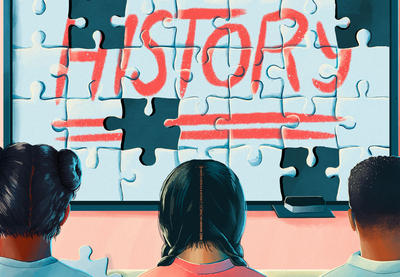On the last day of California’s legislative season, September 30, Gov. Gavin Newsom vetoed AB 331, a bill that would have mandated ethnic studies as a high school graduation requirement. Proponents across the state—including educators who had been deeply involved in the fight for ethnic studies for decades—were shocked by the development. At the crux of Newsom’s decision was continued disagreement over the proposed model ethnic studies curriculum, which inspired contentious public debate over the framing of history and concerns over who is included and excluded as part of ethnic studies.
Throughout the state, rationales supporting the proposed curriculum relied on a common definition of ethnic studies as “the critical and interdisciplinary study of race, ethnicity and indigeneity with a focus on the experiences and perspectives of people of color in the United States.” In the decades since it first emerged from California in the 1960s, advocates nationwide have faced an uphill battle in getting the public, school districts and state legislatures to support and adopt a curriculum that includes the perspectives of groups historically denied the rights outlined in the United States’ founding documents. While the veto of AB 331 was shocking, the bill was a bold step in attempting to address the persistent erasure that students of color in California experience—and it has reignited crucial conversations about the role of ethnic studies across the nation.
Gaining a Foothold
Newsom’s veto was an “unexpected blow,” said Dr. Dale Allender, associate professor of language, literacy and culture in the Department of Teaching Credentials at California State University-Sacramento. After all, if ethnic studies could not be mandated in its birthplace of California, what does that mean for those living in states that have been hostile toward ethnic studies?
But all hope is not lost, said Allender, co-editor of what is believed to be the nation’s first high school ethnic studies textbook, Our Stories in Our Voices.
“The most recent activism fighting anti-Black racism resurfaced the importance of Black studies and the ethnic studies movement. When AB 331 passed the state Legislature, it was a full circle moment,” Allender said. “You see the same sentiments present in the push for ethnic studies today as you did in the ’60s. The recent activism pushed things forward quickly, and people are committed to seeing this through.”

This includes educators like Dr. Theresa Montaño, a professor of Chicana/o studies at California State University Northridge. Montaño was one of the leads on AB 1460, which successfully created an ethnic studies graduation requirement in the Cal State system. She was also an advisory committee member for the first iteration of the California Ethnic Studies Model Curriculum.
Montaño said that when fights for ethnic studies are successful, it’s the result of a coalition of caregivers, community members and teacher activists working together, all of whom understand there will be no “easy wins.”
“When you’re pushing against systemic racism, it takes years to actually attain something, and I think one of the reasons ethnic studies is gaining such a foothold right now is because of the Black Lives Matter movement,” Montaño said.
Many teachers involved in the fight for ethnic studies talk about the continued importance of activism, protest and community coalitions—the same strategies that led to ethnic studies as we know it. In 1968, the Black Student Union and a coalition of other student groups known as the Third World Liberation Front sparked a movement at San Francisco State College (now known as San Francisco State University) that would affect education for decades to come. Student strikers spent five months protesting and performing sit-ins to call attention to the misrepresentation and disregard of Black, Indigenous and people of color in the curriculum. Their activism led to the creation of a Black studies department and the establishment of the College of Ethnic Studies.
A bulk of young people first encounter ethnic studies in college because implementing ethnic studies in K-12 education remains deeply contentious, as evidenced by the challenging, imperfect process and subsequent failure to pass California’s AB 331. The proposed curriculum drew criticism from the Legislature’s Jewish caucus, which questioned why Islamophobia was defined but not antisemitism. Issues were also raised by pro-Israel groups upset by the framing of the Israeli-Palestinian conflict, and Armenian Americans, Indian Americans and Sikhs objected to the model curriculum excluding their experiences.
Ethnic studies is supposed to help us challenge the white supremacy in our curriculum, not aid it.
— Wayne Au
Historically, ethnic studies in California has focused on African Americans, Mexican Americans, Asian Americans and Native Americans. More recently, Wayne Au said, some educators have pushed to transform ethnic studies into “global education” or “multicultural education.”
Au is a professor at the School of Educational Studies at the University of Washington Bothell and an editor for the social justice teaching organization Rethinking Schools, which last year published Rethinking Ethnic Studies, a book offering examples of ethnic studies frameworks, classroom practices and organizing at the school, district and statewide levels. The former high school teacher has long been involved in racial justice work in education on a national scale, and in Seattle and neighboring school districts, he conducts workshops around K-12 ethnic studies implementation.
“For some people, ethnic studies is purely a different version of multicultural education and they want something that’s going to be palatable, something that doesn’t challenge whiteness or white supremacy in schools,” Au said. “Ethnic studies is supposed to help us challenge the white supremacy in our curriculum, not aid it.”
Montaño said it’s imperative that educators work with the same definition of ethnic studies. According to the professor, there are characteristics that make ethnic studies distinct from other disciplines: its history—including where it came from and that it centers race—as well as the struggle against racism and a focus on the groups that racist policies have affected.
“If we can all operate with these understandings, ethnic studies has positive effects on the entire community,” Montaño said.
It was so beautiful to see students make sense of the world and to feel affirmed and seen and feel like their culture matters.
— Mayra Almaraz-De Santiago
Immeasurable Value
The academic and social benefits of ethnic studies are well documented. In 2011, the National Education Association found that when students of different ages are exposed to ethnic studies, they consistently experience “academic achievement, high level of awareness of race and racism, and positive identification with one’s own racial group.” A 2016 study by scholars at Stanford Graduate School of Education also found that a “high school ethnic studies course ... boosted attendance and academic performance of students at risk of dropping out,” Stanford News reports.
What is perhaps more challenging to convey is the transformation educators watch unfold in their classrooms.
21%
the increase in attendance found when a group of students were enrolled in ethnic studies courses.
—Stanford study
“All of a sudden, there is a fire in their hearts and in their bellies. You can see them connecting the dots and begin to understand who they are and how they are in the world and the conditions that they are living in,” Au said. “There is immeasurable value in that. You see kids start to value themselves and their communities, and they start to envision a different future for themselves.”
There is also evidence that ethnic studies propels young people to become educators. Allender said that in California, kids who experience ethnic studies in school are more likely to approach teaching as a career path. Mayra Almaraz-De Santiago, recognized with a 2018 Teaching Tolerance Award for Excellence in Teaching for her work as an ethnic studies teacher, echoes this assertion. Her ethnic studies students at Chicago’s Taft High School were voracious for more learning. They wanted an ethnic studies part two, Almaraz-De Santiago said, or asked if she could teach them ethnic studies again the following year. While she now works as a high school social science specialist for Chicago Public Schools, she maintains communications with former students, many of whom tell her they are pursuing education.

“It was so beautiful to see students make sense of the world and to feel affirmed and seen and feel like their culture matters,” Almaraz-De Santiago said, growing emotional. “Kids would tell me I was their first Mexican American teacher and that they left my class feeling proud of their heritage. Kids told me they wanted to major in ethnic studies or that they were going to major in Latin American Studies. Ethnic studies so clearly had a profound effect on their lives.”
Even having tangential exposure to ethnic studies can change a student’s path; such is the case with Alexis Mburu, a student at Foster High School in Tukwila, Washington. While she’s never taken an ethnic studies class, Alexis has decided to fight for other young people to have the opportunity.
In middle school, Alexis knew of a teacher who taught an ethnic studies class, but she never had the opportunity to take it. This same teacher recognized Alexis’ interest and introduced her to the NAACP and Washington Ethnic Studies Now, which advocates for ethnic studies and focuses on professional development and anti-racist training for educators who want to teach ethnic studies. Alexis is now on the youth advisory board for both organizations.
Alexis said ethnic studies “should be the standard,” noting her interest in education. “When I imagine my younger self and my younger siblings being taught the education they deserve, I see a classroom filled with truth, joy, opportunity and prosperity.”
Best Practices—Beyond Curriculum
While the benefits of ethnic studies are clear, the path forward remains murky—especially in hostile states. However, backlash against ethnic studies can sometimes lead to progress.
In 2010 when former Arizona Governor Jan Brewer signed HB 2281 prohibiting schools from teaching courses “designed primarily for pupils of a particular ethnic group,” it ignited a larger movement across the Southwest, prompting educators in Texas to begin fighting for ethnic studies in K-12 education.
In states where ethnic studies is treated as highly controversial, there is a hyper focus on the curriculum, said Dr. Christopher Carmona, who chairs the National Association for Chicana and Chicano Studies committee for implementing Mexican American Studies in pre-K-12 education. But that’s because of misconceptions about what is being taught, explained Carmona, who is also an associate professor of Mexican American Studies at the University of Texas Rio Grande Valley. Educators have long argued that the curriculum is just one facet of ethnic studies, and of increased importance is training educators.
Teacher activist and TT advisor Tracy Castro-Gill, the executive director of Washington Ethnic Studies Now, explained that teaching ethnic studies requires a completely different approach to education and instructional practices. In the nine-module, 18-hour course she developed for educators interested in teaching ethnic studies, Castro-Gill said it’s only in module nine that curriculum even comes up.
“There’s a fundamental shift that needs to happen first in the understanding that we’re not here to create better workers; we’re here to create better engaged citizens and humans of the world,” Castro-Gill said. “You can’t do that with tidy little rows in your classroom where children only speak when they’re spoken to. It’s a lot about interrogating and deconstructing the white Eurocentric norm of the classroom and expectations of education. That’s what the professional development is based on—that and building on background knowledge about critical race theory and intersectionality and anti-racist theories.”
As the co-chair of the Sacramento State Ethnic Studies Teacher Training Credentialing Consortium, Allender facilitates and provides professional ethnic studies and social justice development for teachers in Northern California. His advice to anyone who wants to teach ethnic studies is that, first, they have to engage in a process of self-study and go through their own ethnic studies journey.
“So many of us were subjected to socio-cultural deprivation, and that causes a tremendous cognitive dissonance,” Allender said. “When you promote ethnic studies, it has to be done programmatically and personally. This work must be done in community because it is more than just readings and tests and papers and presentations. Ethnic studies is rooted in civic engagement, service learning and community collaboration. This has always been about being out in the community as much as it was about being in the books.”
